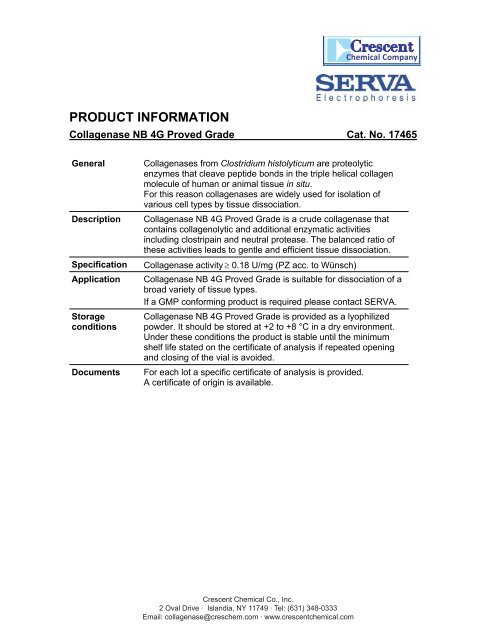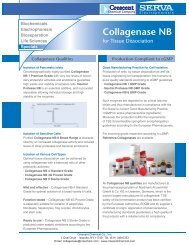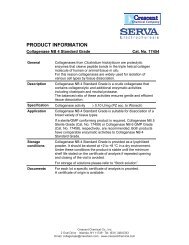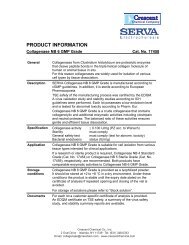Collagenase NB4G Proved Grade Product Information - Crescent ...
Collagenase NB4G Proved Grade Product Information - Crescent ...
Collagenase NB4G Proved Grade Product Information - Crescent ...
You also want an ePaper? Increase the reach of your titles
YUMPU automatically turns print PDFs into web optimized ePapers that Google loves.
PRODUCT INFORMATION<br />
<strong>Crescent</strong><br />
Chemical Company<br />
<strong>Collagenase</strong> NB 4G <strong>Proved</strong> <strong>Grade</strong> Cat. No. 17465<br />
General <strong>Collagenase</strong>s from Clostridium histolyticum are proteolytic<br />
enzymes that cleave peptide bonds in the triple helical collagen<br />
molecule of human or animal tissue in situ.<br />
For this reason collagenases are widely used for isolation of<br />
various cell types by tissue dissociation.<br />
Description <strong>Collagenase</strong> NB 4G <strong>Proved</strong> <strong>Grade</strong> is a crude collagenase that<br />
contains collagenolytic and additional enzymatic activities<br />
including clostripain and neutral protease. The balanced ratio of<br />
these activities leads to gentle and efficient tissue dissociation.<br />
Specification <strong>Collagenase</strong> activity 0.18 U/mg (PZ acc. to Wünsch)<br />
Application <strong>Collagenase</strong> NB 4G <strong>Proved</strong> <strong>Grade</strong> is suitable for dissociation of a<br />
broad variety of tissue types.<br />
If a GMP conforming product is required please contact SERVA.<br />
Storage<br />
conditions<br />
<strong>Collagenase</strong> NB 4G <strong>Proved</strong> <strong>Grade</strong> is provided as a lyophilized<br />
powder. It should be stored at +2 to +8 °C in a dry environment.<br />
Under these conditions the product is stable until the minimum<br />
shelf life stated on the certificate of analysis if repeated opening<br />
and closing of the vial is avoided.<br />
Documents For each lot a specific certificate of analysis is provided.<br />
A certificate of origin is available.<br />
<strong>Crescent</strong> Chemical Co., Inc.<br />
SERVA<br />
2<br />
Electrophoresis<br />
Oval Drive · Islandia,<br />
GmbH <br />
NY<br />
Carl-Benz-Str.<br />
11749 · Tel:<br />
7<br />
(631)<br />
D-69115<br />
348-0333<br />
Heidelberg<br />
Phone + 49 (0) 6221 13840-0 Fax + 49 (0) 6221 13840-10 E-mail info@serva.de http://www.serva.de<br />
Email: collagenase@creschem.com · www.crescentchemical.com
<strong>Crescent</strong> Chemical Co., Inc.<br />
2 Oval Drive · Islandia, NY 11749 · Tel: (631) 348-0333<br />
Email: collagenase@creschem.com · www.crescentchemical.com<br />
<strong>Crescent</strong><br />
Chemical Company<br />
PRODUCT INFORMATION <strong>Collagenase</strong> NB 4G <strong>Proved</strong> <strong>Grade</strong><br />
Instructions for use:<br />
General <strong>Collagenase</strong> NB 4G <strong>Proved</strong> <strong>Grade</strong> is suitable for isolation of a<br />
broad variety of cells from human or animal tissues. Tissue types<br />
include skin, liver, colon tumors, and xenopus ovaries.<br />
Tissue<br />
dissociation<br />
Version 05/12<br />
Recommended starting concentrations for selected applications:<br />
Skin (human, rodent): 0.2 – 0.5 PZ U/ml<br />
Liver (rodent): 0.1 – 0.15 PZ U/ml<br />
In general, the appropriate collagenase concentration depends on<br />
tissue type and origin as well as on the isolation procedure.<br />
Further protocol information for dissociation of several tissue types<br />
is available at www.serva.de.<br />
<strong>Collagenase</strong> activity is at an optimum at 37 °C and pH 7.4.<br />
Stock solution <strong>Collagenase</strong> NB 4G <strong>Proved</strong> <strong>Grade</strong> dissolves at a concentration of<br />
up to 150 mg/ml in all buffers which are commonly used for cell<br />
isolation. The enzyme solution must be constantly stored on ice.<br />
Since collagenase and some of the secondary proteases depend<br />
on calcium, it is recommended to use a buffer with 2 mM Ca 2+ .<br />
Absolutely no calcium chelating agents (e.g. EDTA) should be<br />
present at all.<br />
For 0.22 µm filtration filters with low protein-binding properties<br />
(e.g. cellulose acetate, PVDF, or PES) are recommended.<br />
Working<br />
solution<br />
Inactivation<br />
and inhibitors<br />
To prepare a working solution, the stock solution is diluted with<br />
buffer to achieve the required collagenase concentration. The<br />
working solution must be constantly stored on ice until use.<br />
The dissociation process can be reduced, e.g. by cooling down or<br />
dilution of the enzyme solution.<br />
<strong>Collagenase</strong> is reversibly inactivated at high pH values and<br />
irreversibly inactivated at low pH values. Inhibitors of collagenase<br />
include cysteine or chelating agents like EDTA.<br />
Important note <strong>Collagenase</strong> NB 4G <strong>Proved</strong> <strong>Grade</strong> is not intended for direct<br />
application in humans.






